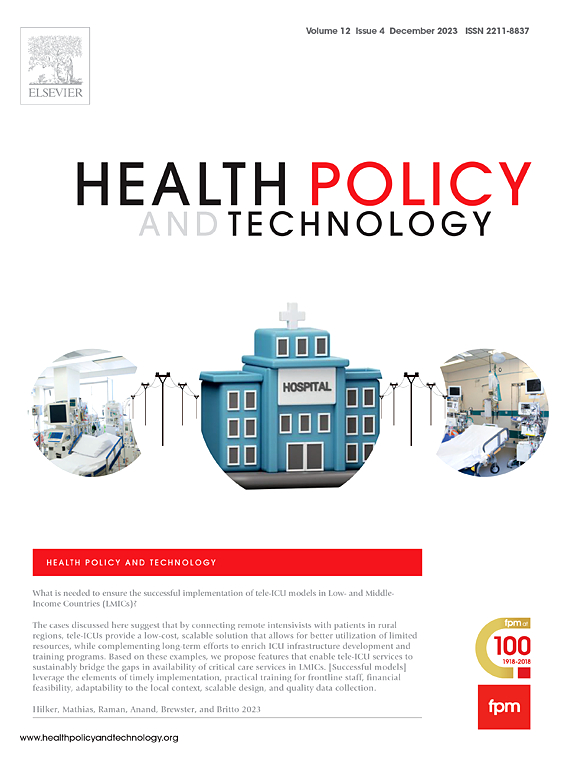Digital COVID-19 symptom screening and SARS-CoV-2 testing through RT-LAMP saliva of students and asymptomatic employees in a public school in Brazil
IF 3.7
3区 医学
Q1 HEALTH POLICY & SERVICES
引用次数: 0
Abstract
Children were the last that were vaccinated during the COVID-19 pandemic. In this scenario, schools were the site of amplification and spread of COVID-19 and new variants during the pandemia.
Objective
To evaluate a respiratory symptoms screening system and test asymptomatic individuals (high school students and employees) at a public school in Brazil.
Methods
An online COVID-19 symptom surveillance platform was implemented for employees and students answered a questionnaire by mobile phone and/or website before going to school. Symptomatic individuals were referred to primary care unit. SARS-CoV-2 reverse transcription loop- mediated isothermal amplification (RT-LAMP) of saliva samples was performed weekly. The test cost was estimated.
Results
A total of 969 samples were tested (mean of 108 tests per week). A professor was symptomatic and tested positive during the study period. However, no asymptomatic participants tested positive for COVID-19, and no cases of SARS-CoV-2 transmission occurred at school despite the high transmissibility of the Delta variant, the local predominant variant at the time of the study and several outbreaks that occurred in public schools in Brazil. The average cost of our test was $13,6 per test.
Conclusion
Implementation of an online system of COVID-19 respiratory symptom screening and testing SARS-CoV-2 through saliva in asymptomatic individuals is a feasible, low-cost and practical option to be used, especially in low-income countries.
巴西某公立学校学生和无症状员工的数字COVID-19症状筛查及RT-LAMP唾液检测
儿童是COVID-19大流行期间最后一批接种疫苗的人。在这种情况下,学校是COVID-19和新变种在大流行期间扩增和传播的场所。目的评价巴西一所公立学校的呼吸道症状筛查系统,并对无症状个体(高中生和教职工)进行检测。方法建立新冠肺炎症状在线监测平台,对员工和学生在上学前通过手机和(或)网站填写问卷。有症状的个体被转介到初级保健单位。每周对唾液样本进行SARS-CoV-2逆转录环介导的等温扩增(RT-LAMP)。估算了测试成本。结果共检测样本969份,平均每周检测108份。一位教授在研究期间出现症状并检测呈阳性。然而,没有无症状的参与者在COVID-19检测中呈阳性,并且在学校没有发生SARS-CoV-2传播病例,尽管Delta变体(研究时当地的主要变体)具有高传播性,并且在巴西的公立学校发生了几次暴发。我们每次测试的平均成本是13.6美元。结论在无症状人群中实施COVID-19呼吸道症状在线筛查和唾液检测系统是一种可行、低成本和实用的选择,特别是在低收入国家。
本文章由计算机程序翻译,如有差异,请以英文原文为准。
求助全文
约1分钟内获得全文
求助全文
来源期刊

Health Policy and Technology
Medicine-Health Policy
CiteScore
9.20
自引率
3.30%
发文量
78
审稿时长
88 days
期刊介绍:
Health Policy and Technology (HPT), is the official journal of the Fellowship of Postgraduate Medicine (FPM), a cross-disciplinary journal, which focuses on past, present and future health policy and the role of technology in clinical and non-clinical national and international health environments.
HPT provides a further excellent way for the FPM to continue to make important national and international contributions to development of policy and practice within medicine and related disciplines. The aim of HPT is to publish relevant, timely and accessible articles and commentaries to support policy-makers, health professionals, health technology providers, patient groups and academia interested in health policy and technology.
Topics covered by HPT will include:
- Health technology, including drug discovery, diagnostics, medicines, devices, therapeutic delivery and eHealth systems
- Cross-national comparisons on health policy using evidence-based approaches
- National studies on health policy to determine the outcomes of technology-driven initiatives
- Cross-border eHealth including health tourism
- The digital divide in mobility, access and affordability of healthcare
- Health technology assessment (HTA) methods and tools for evaluating the effectiveness of clinical and non-clinical health technologies
- Health and eHealth indicators and benchmarks (measure/metrics) for understanding the adoption and diffusion of health technologies
- Health and eHealth models and frameworks to support policy-makers and other stakeholders in decision-making
- Stakeholder engagement with health technologies (clinical and patient/citizen buy-in)
- Regulation and health economics
 求助内容:
求助内容: 应助结果提醒方式:
应助结果提醒方式:


